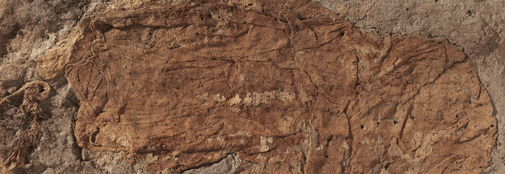Hammerum

The Hammerum project is an interdisciplinary research project with participation of many different researchers. The core investigators are Hans Rostholm, Ulla Mannering and Lise Ræder Knudsen. The project is based on collaborative effort cross institutions and involving disciplines such as prehistoric archaeology, textile research and natural science.
In 1993 during the construction of a new road a small cemetery containing seven inhumation graves were located in Hammerum near Herning in Jutland, Denmark. Four of the graves were excavated on site, but unfortunately they did neither contain any remains of the buried bodies nor of any grave goods. The three remaining graves on the other hand, yielded great surprises as it was discovered that they contained well preserved organic materials.
Therefore these graves were taken up as whole blocks of soil and brought to the local conservation department. The first grave to be excavated contained a wooden coffin covered by a well preserved wooden lid (Grave 8). The other two graves (Grave 100 and 83) had on the excavated surfaces clear traces of wood, human hair and textiles. For various reasons the excavation of the two graves never continued, and they were kept in storage until 2009 when this project was launched. The graves are C14 dated to the late Roman Iron Age (AD 200-400 AD).
Grave 100
Grave 100 was the first to be examined, but unfortunately not much organic material was preserved. The grave had a visible layer of an indeterminable dark brown organic substance and together with a few shadows of bones from the deceased it could be determined that the body had lain on the left side with the legs bent in front of the chest. Based on the remains of human hair arranged in a nice coiffure the grave is interpreted as a female burial. No textiles but a few remains of an animal hide were detected. Unfortunately it cannot be determined whether it came from a skin costume or the lining of the grave.
The Hammerum Girl
Grave 83 is an archaeological sensation as it contains an inhumation grave with incredibly well preserved textiles. The grave is interpreted as that of a woman based on the preserved hairdo. The textile costume consists of three pieces of clothing; a dress and two other pieces. No metal object were present in the grave, only three chards of ceramics lay on the chest of the deceased on top of a bone pin. The Hammerum Girl’s grave provides a unique opportunity to study costume details that in most cases has disappeared. Therefore it has for scientific and popularizing purposes been decided to keep the textiles in their original position almost as they were found, and not to remove and unfold them.
Apart from textile and dye analyses, fiber analysis, high magnification photography, CT-scanning and scientific analyses of the micro environment, wood and pollen analyses, and strontium and stable isotopes analyses are employed to shed light on the preservation conditions in the grave and to gain more information about the outfit and the buried person. All the performed analyses will be published in the final publication which is currently being prepared. The grave is now on display in the exhibition at Herning Museum.
Participating institutions and researchers
Archaeology: Hans Rostholm, Herning Museum
Excavation and conservation: Lise Ræder Knudsen, Anne-Kathrine Kjerulff, Louis Lange Wollesen, Conservation Centre Vejle, and Irene Skals, National Museum of Denmark
Textile analysis: Ulla Mannering, National Museum of Denmark and Lise Ræder Knudsen, Conservation Centre Vejle
Wood analysis: Peter Hambro Mikkelsen, Moesgård Museum
Pollen analysis: Renée Enevold, Moesgård Museum
Strontium isotope analysis: Karin Margarita Frei, CTR, University of Copenhagen
Stable isotope analysis: Andrew Wilson, Bradford University, UK
Dye analysis: Ina Vanden Berghe, KIKIPPA, Brussels, Belgium
Carbon14 dating: Jan Heinemeier, AMS 14C Datering Centre, Århus University
Fibre identification and analysis: Irene Skals, The National Museum of Denmark
Biological observations: Frank Jensen, Naturhistorisk Museum, Århus
Micromorphological analysis: Nina Helt Nielsen, Moesgård Museum
Archaeometric analysis of soil: Michelle Taube and Jens Glastrup, The National Museum of Denmark
CT-scanning: Niels Lynnerup, University of Copenhagen
The project is funded by The Heritage Agency of Denmark and The Danish National Research Foundations Centre for Textiles Research.
Publications
Kjerulff, A.-K. og L. R. Knudsen. 2010: Udgravning og konservering af Hammerum-pigen. Herning Museum. Midtjyske fortællinger 2010, 115-120.
Mannering, U., Ræder Knudsen, L. og Rostholm, H. (2010) Pigen fra Hammerum. Skalk 2010:5, 3-8.
Mannering, U. and Ræder Knudsen, L. (forthcoming) The Hammerum Woman. NESAT XI conference proceeding.
Mannering, U. (2012): Dragt og design i romersk jernalder på Herningegnen. Herning Museum. Midtjyske fortællinger 2011.
Enevold, R. (2011) Hvad dragten gemte. Skalk 2011:3, 27-30.
Rostholm, H. 2008: Fund fra Tornebuskehøj i Hammerum. Herning Museum. Midtjyske fortællinger 2008, 141.
Rostholm, H. 2009: Herning Museums arkæologiske virksomhed. Herning Museum. Midtjyske fortællinger 2009, 33-36.
Rostholm, H. 2010: Herning Museums arkæologiske virksomhed. Herning Museum. Midtjyske fortællinger 2010, 73-74.
Rostholm, H. 2010: Hammerum-pigens findested. Herning Museum. Midtjyske fortællinger 2010, 103-114.
